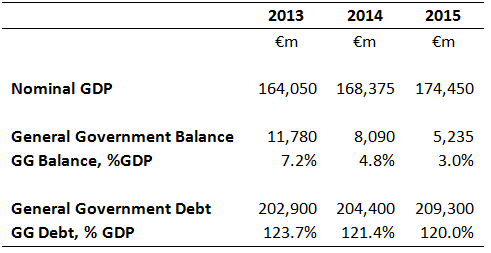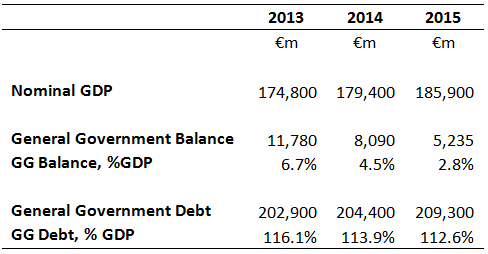The Irish Times has a piece on US corporate “inversions” which says that “Ireland’s tax regime comes under US spotlight again”. In this instance an inversion is where a US company merges with a non-US company and the merged holding company has its place of incorporation outside the US. Under current rules the owners of the foreign company have to comprise at least 20 per cent of the ownership of the merged holding company for such an inversion to take place. Some of the technical details about inversions and Ireland can be found here.
In the US Congress, Rep. Sander Levin (D), who is on the Ways and Means Committee has highlighted findings from the Congressional Research Library that US companies have been involved in 76 such inversions since 1983. That is an average of less than 3 per year but the rate has increased in the past decade as shown in this related infographic.
It is not clear from the documents how many of the inversions have involved mergers with Irish companies or the incorporation in Ireland of the merged holding company but it is probably around 10 per cent of the total.
From an Irish perspective inversions offer very little. Simon Carswell’s report today says that:
The practice is known as inversions where an American company acquires or merges with a foreign company that allows it to relocate its legal address for tax purposes outside the US to avoid paying the high American corporate tax rate of 35 per cent.
The report refers to inversions by US companies in recent years involving Irish-based firms including pharmaceutical companies Elan, Mallinckrodt and Warner Chilcott to benefit from the lower Irish corporate tax rate of 12.5 per cent.
This might suggest that the merged companies will be paying tax on a greater amount of profits at the 12.5 per cent Corporation Tax to Ireland. This is unlikely to be the case. Although the original US company may move its place of incorporation and tax residence to Ireland in many cases there is little substantial change in the operations of the companies.
If the US companies continue to have significant operations in the US (and they will) they will continue to be liable for the US corporate income tax of 35 per cent on the profits earned by those operations. Place of incorporation has a limited role in determining tax liabilities. The key factors are the location of a company’s risks, assets and functions with transfer pricing rules used to allocate profit across the company’s risks, assets and functions. A legal inversion changes none of these.
The fact that the inversion changes so little of the tax liability is shown in further research cited by Rep. Levin but this time from the staff of the Joint Committee on Taxation. This shows that if a proposal from Rep. Levin to limit US companies ability to invert their place of incorporation abroad the revenue gains over ten years to the US Treasury would be $19.5 billion. That averages less than $2 billion a year.
The gain is relatively small because the US continues to levy the 35 per cent tax on the operations of the company in the US. What the US loses out on is the right to levy its 35 per cent tax on the global, i.e. non-US, profits of these companies. And it is also the case that the extensive deferral provisions for these tax liabilities means that much of that is not collected.
For comparison in Irish terms the tax revenues gains estimated by the JCT scaled for size in Ireland would be the equivalent of around €15 million in Corporation Tax a year which is 0.4 per cent of current receipts. Of course, there is more to it than just the tax revenue as companies are seen as reneging on their US identities.
Unless the companies move some risks, functions or assets to Ireland as part of the inversion they are unlikely to pay any additional tax in Ireland (above what was paid on activities in Ireland, if any, before the merger). Like the US, Ireland has a worldwide basis for the Corporation Tax. However, the companies will pay corporate income tax in the source country where there risks, functions and assets are.
Ireland will levy a 12.5 per cent tax on such trading profits but will grant a tax credit for corporate income tax in other countries. If the amount of tax paid abroad results in an Irish foreign tax credit greater than 12.5 per cent of the taxable income then the amount of additional tax due in Ireland will be nil.
This is almost always going to be case as virtually every country these companies operate in have a corporate income tax rate greater than Ireland’s 12.5 per cent. This is particularly the case if the inversions involve US companies which keep most of their risks, assets and functions in the US and remain liable to the US 35 per cent corporate tax rate for profits sourced from the US.
The gain for the companies is clear. They will no longer be liable to pay the US 35 corporate income tax on their global, i.e. non-US, profits. This is one of the highest corporate income tax rates in the world so means that US companies do face an additional tax liability on their non-US profits even when they get a credit for foreign corporate income tax paid in the source country. Of course, US companies can use the extensive deferral provisions in the US tax code to delay the actual payment of this tax liability until the money is formally repatriated to the US and in some cases this deferral can be indefinite.
By inverting their residence to a a country such as Ireland companies can reduce the additional tax they have to pay on top of the tax paid in the source country. For most of these companies the source country will remain the US and it is also likely that the US authorities will be more active in assessing the structures, and particularly the transfer pricing arrangements, of these companies to ensure that the appropriate amount of profit is attributed to the risks, assets and functions in the US and not deemed “offshore”.
Also in the piece, Simon Carswell references a note from a US law firm on the practice of inversions. The note rightly highlights some costs of these inversions to Ireland. There will be no additional tax revenue but Ireland’s contribution to the EU budget may increase if the companies cause an increase in Irish GNP. There can be one-off effect (if the US company has retained earning on its balance sheet at the time of it residence relocation to Ireland) and an ongoing effect (if the company generates profits that are not distributed to shareholders but are added to retained earnings). As the merged company is Irish resident this income is added to Irish GNP.
The ‘takeaway’ in the note is that US firms seeking to invert to Ireland should do more than the basic minimum required which does not require the relocation of any significant risks, assets or functions. The law firm concludes that:
Although not a requirement, corporations should consider tangible investments beyond the requisite minimum of board meetings, including the establishment of accounting and treasury, legal, intellectual property and business development functions; the appointment of an Irish advisory board or resident Irish directors; and the establishment of regional trading or intellectual property hubs.
If some of these came to Ireland as part of an inversion then there might be gains here. Absent them we are likely to continue to see articles on Ireland’s Corporate Tax regime. And the attention may not be in the right place. Sander Levin was not shining a spotlight on Ireland’s tax regime; he was shining it on the US regime which in the first instance makes these inversions attractive (due to its relatively high rate) and in the second instance allows them (with a low legal barrier to inversions).
There is nothing Ireland can do about these inversions. We rightfully have freedom of establishment and, within certain limited restrictions, allow people to set up companies here. There is nothing underhand that makes Ireland attractive for these inversions. There is the low rate, stable regime, legal system, EU membership, network of tax treaties and all that.
Changing these could reduce the attractiveness for inversions from which Ireland gains nothing bar unwanted, and maybe even unwarranted, attention but these are the key attributes Ireland uses to attract traditional foreign direct investment which brings a much more tangible benefit – employment. As the policy of attracting FDI is likely to remain it looks like inversions will be a negative side effect of an attractive regime unless the US can overcome the paralysis in Congress and actually do something about it. That would be a positive for Ireland but it seems unlikely.




